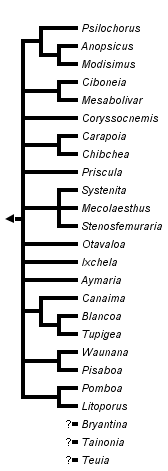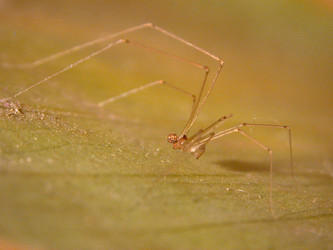New World clade
Dimitar Dimitrov


This tree diagram shows the relationships between several groups of organisms.
The root of the current tree connects the organisms featured in this tree to their containing group and the rest of the Tree of Life. The basal branching point in the tree represents the ancestor of the other groups in the tree. This ancestor diversified over time into several descendent subgroups, which are represented as internal nodes and terminal taxa to the right.

You can click on the root to travel down the Tree of Life all the way to the root of all Life, and you can click on the names of descendent subgroups to travel up the Tree of Life all the way to individual species.
For more information on ToL tree formatting, please see Interpreting the Tree or Classification. To learn more about phylogenetic trees, please visit our Phylogenetic Biology pages.
close boxCharacteristics
The New World clade includes a quite heterogeneous group of pholcid genera; all of them, as the name of the clade indicates, are known from the New World. Spiders in this group also share some morphological synapomorphies such as the exposed tarsal organ, male palpal coxa with a retrolateral apophysis, large distance between the posterior median and the anterior lateral eyes, male gonopore without epiandrous spigots and anterior lateral spigots with only one piriform gland each.
Discussion of Phylogenetic Relationships
The exact limits of this group are still unclear. A fairly large sample of New World genera was included in two phylogenetic studies (Huber, 2000; Bruvo-Madaric at al., 2005) but both failed to find an unambiguous solution for the exact limits of this group and the internal relationships of the included genera. Therefore, “New World clade” is used as an informal name referring to the group of New World pholcid genera found to be more closely related to each other than to the rest of the genera in the family. Addition of more data and expanding the taxon sample may help to answer these questions. Several genera which have some of the New World clade synapomorphies are listed here but their position was not tested in a phylogenetic analysis.
References
Bruvo-Madaric B., Huber B.A., Steinacher A., Pass G. 2005. Phylogeny of pholcid spiders (Araneae:Pholcidae): combined analysis using morphology and molecules. Molecular Phylogenetics and Evolution 37: 661-673.
Huber B.A. 2000. New World pholcid spiders (Araneae: Pholcidae): a revision at generic level. Bull. Amer. Mus. Nat. Hist. 254: 1–348.
Title Illustrations

| Scientific Name | Modisimus mango |
|---|---|
| Location | Haiti |
| Specimen Condition | Live Specimen |
| Identified By | Bernhard Huber |
| Sex | Male |
| Life Cycle Stage | Adult |
| Copyright |
© 2007 Bernhard A. Huber

|
About This Page
Dimitar Dimitrov

Zoological Museum, University of Copenhagen
Correspondence regarding this page should be directed to Dimitar Dimitrov at
Page copyright © 2009 Dimitar Dimitrov
 Page: Tree of Life
New World clade.
Authored by
Dimitar Dimitrov.
The TEXT of this page is licensed under the
Creative Commons Attribution-NonCommercial License - Version 3.0. Note that images and other media
featured on this page are each governed by their own license, and they may or may not be available
for reuse. Click on an image or a media link to access the media data window, which provides the
relevant licensing information. For the general terms and conditions of ToL material reuse and
redistribution, please see the Tree of Life Copyright
Policies.
Page: Tree of Life
New World clade.
Authored by
Dimitar Dimitrov.
The TEXT of this page is licensed under the
Creative Commons Attribution-NonCommercial License - Version 3.0. Note that images and other media
featured on this page are each governed by their own license, and they may or may not be available
for reuse. Click on an image or a media link to access the media data window, which provides the
relevant licensing information. For the general terms and conditions of ToL material reuse and
redistribution, please see the Tree of Life Copyright
Policies.
- First online 12 February 2009
- Content changed 12 February 2009
Citing this page:
Dimitrov, Dimitar. 2009. New World clade. Version 12 February 2009 (under construction). http://tolweb.org/New_World_clade/135149/2009.02.12 in The Tree of Life Web Project, http://tolweb.org/







 Go to quick links
Go to quick search
Go to navigation for this section of the ToL site
Go to detailed links for the ToL site
Go to quick links
Go to quick search
Go to navigation for this section of the ToL site
Go to detailed links for the ToL site